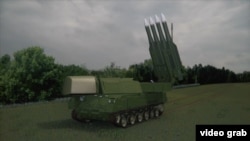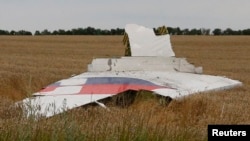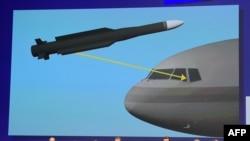The Kremlin has been having a bad week, in terms of global public relations. On May 24, the Dutch Joint Investigation Team (JIT) presented its findings on the Buk TELAR surface-to-air missile system that shot down Malaysian Airlines flight MH-17 over eastern Ukraine on July 17, 2014. The investigators revealed they were able not only to determine that the system was provided from Russia, but to identify the military unit it belonged to -- the 53rd anti-aircraft missile brigade of the Russian armed forces.
The next day, the governments of Australia and the Netherlands officially declared that they hold Russia responsible for the incident, which claimed many Dutch and Australian nationals among the victims.
A few days earlier, on May 22, the independent Russian newspaper Novaya Gazeta published an open letter to the Russian people from the families of MH-17 victims stressing that they do not blame the Russian people for the actions of their government and military. However, it also included a paragraph on the Russian government’s deliberate campaign of disinformation surrounding the event.
“In the first months some of us were troubled by the multiple, often contradictory stories about what happened to MH-17 coming out of Russia,” the letter reads.
The letter cites examples of these alternative explanations:
- “MH-17 was shot down by a Ukrainian jet.”
- “It was blown up by a missile intended for the Russian President’s plane.”
- “It was already full of dead bodies and deliberately crashed.”
- “It was shot down by a BUK missile but not one of Russia’s.”
Indeed, the Kremlin and its media have put forward a number of contradictory and highly implausible alternative theories on MH-17, and with the JIT’s recent revelations it is worth remembering some of the most infamous ones.
Taking a shot at Putin
One early version of the crash which the Russian state media tried peddle was that the Malaysian Airlines Boeing-777 was shot down by Ukrainian forces who had mistaken it for Russian President Vladimir Putin’s plane. RT posted a story about the report, but also cited other Russia media contradicting the claim that Putin’s plane had overflown Ukrainian territory. This story would soon be dropped.
A Ukrainian Buk
While the Russian media didn’t stick with the Putin assassination attempt theory for very long, they did initially run with the Russian Defense Ministry’s claim that the passenger airline had indeed been shot down by a Buk SAM system, but a Ukrainian one. On July 18, 2014, only one day after the crash, RT published a story in which the Russian Defense Ministry claimed a Ukrainian Buk SAM system had been detected in the vicinity of the crash site.
A Ukrainian jet
There were also claims that a Ukrainian military jet downed the airliner, often identifying the aircraft responsible as a Su-25, a Soviet-designed ground attack aircraft possessed by both Ukraine and Russia.
In one now-infamous story, Russian state media cited a man identified as “Carlos,” who claimed to be a Spanish air traffic controller who had for some reason been on duty in the tower of Kyiv’s Boryspil International Airport. Carlos, known only by his Twitter account, tweeted that he had seen two Ukrainian military jets near flight MH-17 on his radar screen. Shortly thereafter, Carlos disappeared for several years until RFE/RL finally caught up with the man behind the account.
Perhaps the most offensive version of the airplane theory was that of Odnako (However), a political program on Russian state television’s Channel One.On November 14, 2014, the show’s host claimed he had received an American satellite photo from an MIT graduate engineer named George Bilt. The photograph depicted a Boeing-777 in flight, with a MiG-29 fighter jet attacking it at an almost perpendicular angle. Streaks coming from the Mig-29 appeared to indicate a missile or possibly cannon fire. The photograph was not only quickly debunked as a crude forgery, but its actual origin was discovered to be a Russian internet forum, not an engineer from MIT.
Another popular Su-25 theory revolves around a now-deceased Ukrainian Air Force captain, Vladislav Voloshyn. In late 2014, Russia’s Investigative Committee announced that it had an anonymous witness who served as a member of the ground crew at the air base where Voloshyn was stationed. This witness allegedly told Russian investigators that he saw Voloshyn’s plane return to base with an air-to-air missile missing from its mount and that Voloshyn was extremely nervous when he exited his plane. This story was revived once more in 2018, after Voloshyn committed suicide.
A Ukrainian Buk, again
On June 2, 2015, Almaz-Antey, the Russian arms manufacturer which produces the Buk TELAR SAM system held a press conference at which it denied any responsibility shooting down MH-17. Almaz-Antey’s investigation confirmed that MH-17 had indeed been shot down by a Buk SAM, but that the particular missile used was only in use by Ukraine and not Russia at the time. Furthermore, Almaz-Antey claimed that the launch site was near the village of Zaroshchenske, which it claimed was under Ukrainian military control at the time the airliner was shot down. Both claims were debunked.
First, it was determined that the missile Almaz-Antey claimed was no longer used by the Russian armed forces actually is still being used by that military. Secondly, Zaroshchenske is not only disputed as a potential launch site, but was under the control of Russian forces when MH-17 was shot down, rendering this claim moot.
A hint of truth
While Russian state media continue to spin alternative theories of what happened on July 17, 2014, sometimes they hint at what really happened. Shortly before the crash of MH-17 was reported, a social media account associated with Igor “Strelkov” Girkin, a Russian citizen and commander of “rebel” forces in the Donbas, bragged about downing a Ukrainian military An-26 cargo plane in the vicinity of MH-17’s crash site. The post showed photos of a rising column of smoke and a warning to the Ukrainian military to “stay out of our sky.”
Once it became clear that it was MH-17 and not an An-26 which had been shot down, the post disappeared, and the alternative theories began. However, Russian state media cited the post in initial stories about the downing of a Ukrainian An-26, and some of those pieces are still online today.
For those readers who would like to explore the wide variety of alternate MH17 scenarios from Russian state and private media as well as pro-Kremlin sites, EU vs Disinfo has compiled a list of 57 different cases.






